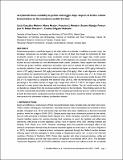Por favor, use este identificador para citar o enlazar a este item:
http://hdl.handle.net/10261/286288COMPARTIR / EXPORTAR:
 SHARE SHARE
 CORE
BASE CORE
BASE
|
|
| Visualizar otros formatos: MARC | Dublin Core | RDF | ORE | MODS | METS | DIDL | DATACITE | |

| Título: | Acrylamide bioaccessibility in potato and veggie chips. Impact of in vitro colonic fermentation on the non-bioaccessible fraction |
Autor: | González-Mulero, Lucía CSIC; Mesías, Marta CSIC ORCID ; Morales, F. J. CSIC ORCID ; Navajas-Porras, B.; Rufián Henares, J. A. CSIC ORCID; Delgado Andrade, Cristina CSIC ORCID | Fecha de publicación: | 2023 | Editor: | Elsevier | Citación: | Food Research International 164: 112409 (2023) | Resumen: | Potato-based products contribute largely to the daily intake of acrylamide. In addition to potato crisps, the European Commission has included veggie crisps in the list of foods that should be monitored for their acrylamide content. In the present study, acrylamide content in potato and veggie chips (sweet potato, beetroot and carrot) and their bioaccessibility after in vitro digestion was assessed. The non-bioaccessible fraction was also submitted to in vitro fermentation under colonic conditions. Faecal samples from volunteers of three age groups (children, adolescents and adults) were used to evaluate the microbiota effect on the acrylamide availability. Sweet potato chips exhibited the highest acrylamide content (2342 µg/kg), followed by carrot (1279 µg/kg), beetroot (947 µg/kg) and potato chips (524 µg/kg). After in vitro digestion, acrylamide bioaccessibility was significantly lower in veggie chips (59.7–60.4 %) than in potato chips (71.7 %). Potato and sweet potato chips showed the significantly lowest acrylamide content in the non-bioaccessible fraction (22.8 and 24.1 %, respectively) as compared with beetroot chips (28.4 %). After the fermentation step, acrylamide percentage in the soluble fraction of veggie chips ranged from 43.03 to 71.89 %, the highest values being observed in sweet potato chips fermented with microbiota from children. This fact would involve that the acrylamide was released from the non-bioaccessible fractions by the microbiota. These findings point out that the levels of potentially absorbable acrylamide after the complete gastrointestinal process could be modulated by both the food matrix composition and the microbiota. These factors should be further considered for a more precise risk assessment of dietary acrylamide in humans. | Versión del editor: | https://doi.org/10.1016/j.foodres.2022.112409 | URI: | http://hdl.handle.net/10261/286288 | DOI: | 10.1016/j.foodres.2022.112409 | ISSN: | 0963-9969 |
| Aparece en las colecciones: | (ICTAN) Artículos |
Ficheros en este ítem:
| Fichero | Descripción | Tamaño | Formato | |
|---|---|---|---|---|
| 144_OPEN_SCI_ACRILAMIDA_FERMENTACIONES.pdf | 728,27 kB | Adobe PDF |  Visualizar/Abrir |
CORE Recommender
SCOPUSTM
Citations
2
checked on 24-abr-2024
Page view(s)
44
checked on 27-abr-2024
Download(s)
12
checked on 27-abr-2024
Google ScholarTM
Check
Altmetric
Altmetric
Este item está licenciado bajo una Licencia Creative Commons

